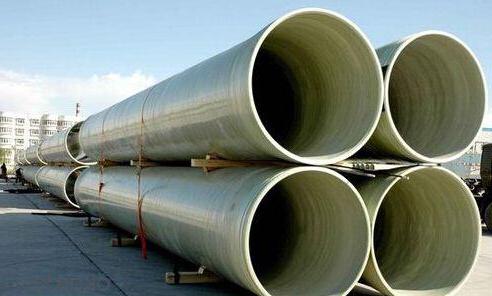Fiberglass pipes are an excellent alternative to traditional materials such as steel, ductile iron and concrete. They have excellent strength, corrosion resistance, light weight, easy to operate and install. They have a smooth surface that provides a higher flow rate, which reduces energy consumption.
Fiberglass is a common type of fiberglass reinforced fiber . The fibers can be randomly placed, pressed into a sheet, or woven into a fabric. The plastic matrix may be a thermosetting polymer matrix, most often based on thermosetting polymers such as epoxy resin, polyester resin or vinyl ether.
History
From the mid to the late 1980s, the growth of production and use of large-diameter underground composite pipes began. Technological advances in the process of winding threads, corrosion resistance and strong market factors have contributed to the popularity of fiberglass pipes. Definitions of what constitutes a large diameter pipe may vary, but overall sizes range from 12 to 14 inches.
Composite or fiberglass pipes are used in a wide range of industries, such as power generation, petrochemicals and seawater desalination. Fiberglass pipe is resistant to corrosion, has a long life cycle, which often exceeds 30 years, and is the best alternative to steel and other metal alloys, malleable cast iron and concrete. According to statistics, more than 60,000 km of large-diameter pipes work worldwide.
Application area
Main areas of use:
- Heat supply and cooling.
- Steam condensate return pipe.
- Hot and cold water supply.
- Condenser and cooling tower.
- Underground fire lines.
- Pipelines.
Thermal expansion and contraction
Fiberglass pipe has different thermal expansion in the diagonal and axial direction. In the direction of the circle, the thermal expansion is approximately the same as that of steel. However, in the axial direction, the thermal expansion is approximately two times greater than that of steel.
The relatively low modulus of elasticity of a fiberglass pipe is an advantage that should be considered when designing a piping system. Since thermal forces are less, restrictive equipment (guides, anchors) should not be as powerful and heavy as for steel pipelines. There is some growth due to the final pressure load in the piping system, but experience has shown that this change in length does not need to be taken into account when designing a fiberglass piping system. Composite piping systems can handle thermal shocks between maximum rated operating temperatures if the pipe connections are not mechanical.
Characteristics
Fiberglass pipes have the following advantages:
- long service life due to excellent resistance to corrosion and chemical attack (salt water, CO 2 , H 2 S, solvents, thermal and oil water);
- easy handling and light weight (approximately ¼ steel weight);
- require less personnel and equipment for installation;
- quick installation thanks to fittings and lower installation costs;
- improved flow characteristics due to smooth inner coating and reduced material resistance.
Fiberglass Pipes: Specifications
The main reason for the increased use and popularity of fiberglass is such key advantages as a high strength to weight ratio, dimensional stability, good mechanical properties, ease of installation, reduced installation and maintenance costs and overall durability in extreme conditions. Another advantage of a fiberglass pipe is that it has a smoother inner surface than traditional building materials. The smooth inner hole resists large-scale deposits and can create a large flow of service fluid throughout the life of the project.

When designing an underground pipe of large diameter, many considerations must be taken into account: local soil conditions, groundwater depth, burial and living loads, deviation due to errors and operating temperatures, fluid speed and pressure, pressure losses due to turbulent flow, hydraulic hammer, pressure on bending and pulsation pressure. Designing an appropriate underground piping system is a complex process that involves extensive calculations - product design must always be carried out by qualified engineers.
Fiberglass composite pipe
In the manufacture of fiberglass pipes , various epoxy and vinyl ester resins and, if necessary, corrosion barriers are used to achieve optimal performance for any practical application. A wide range of temperatures and pressures allows the best choice of fiberglass pipe to the requirements of a particular application.
High-pressure fiberglass pipes are time-tested, because they have been used in harsh conditions for decades and have proven their durability and value. The first samples appeared more than 40 years ago.
Advantages of fiberglass composite pipe systems:
- increased resistance to corrosion / abrasion when exposed to strong acids;
- high strength;
- pipe spans are similar to steel counterparts;
- high quality polyvinyl chloride for higher temperatures and longer piping distances;
- optimal replacement for steel pipe with external or corrosive internal coating.
Fiberglass pipe diameters range from 1 to 72 inches.
Microbiologically induced corrosion
This vulnerability is a common problem in industrial processes due to the presence of microbes. This ultimately leads to the formation of gaps, with oxygen and ion concentration cells, which allows corrosion to progress.
If they are not treated with a fiberglass repair kit, the piping systems will be significantly weakened, often forming holes in the walls of the pipes, resulting in leaks and loss of fluid.
The treatment can be performed by protecting pipelines with cathodic protection or by chemically treating the liquid, which in itself can combine corrosion.
Any of these methods requires additional costs that can only delay the failure.
Fittings & Accessories
Fiberglass pipe accessories are made from epoxy and vinyl ester resins. These adhesives provide the best corrosion resistance and temperature characteristics.
Fittings include flanges, couplings, tees, gears, drain pipes, repair kits, fiberglass repair kits, and more. Fiberglass pipes are designed for harsh operating conditions and are suitable for a wide range of chemicals listed in the fiberglass chemical resistance guide.
All fittings are supplied with a pipe or flange connection for easy field installation. The prices of fiberglass pipes include all the accessories necessary for installation and vary in the range from 4,350 to 47,900 rubles per linear meter, depending on the diameter.